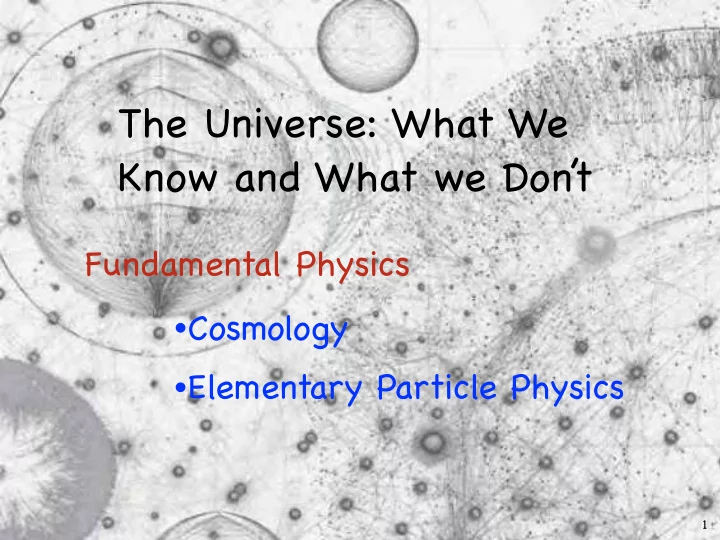

The Universe: What We Know and What we Don’ t Fundamental Physics • Cosmology • Elementary Particle Physics 1
Cosmology Study of the universe at the largest scale • How big is the universe? • Where did the universe come from? • What is the fate of the universe? • Are there other universes? How many? • What is dark matter? • What is dark energy? 2
Elementary Particle Physics Study of the small scale structure of the universe • What are the basic building blocks? • How do they interact with one another? • Is there a smallest amount of space and time? • Is there a theory of everything?
Particle-Wave Duality Energy inversely E ∝ 1 proportional to wavelength λ λ lower energy higher energy 4
Study of small distances requires high energy probes Large Hadron Collider Energy scale 10 3 GeV Distance scale 10 − 19 m Temperature 10 16 K 5
Big Bang 14 billion years ago the universe was much denser and hotter than today Has been expanding and cooling ever since To know the state of the universe at earlier and earlier times, need to know physics at higher and higher energy scales (smaller and smaller distances) 10 − 12 s 10 16 K after Big Bang 6
What we Know • Physics down to a distance scale of 10 − 19 m • Physics down to a time of 10 − 12 s after the Big Bang 7
How big is the universe? We don’ t know • At least about 100 times larger than the visible universe • Could be infinite 8
Steady State Universe Pre 20th century • Stars fixed points in space • Universe unchanging 9
General Relativity Eistein 1915 • Gravity due to curvature of space-time 10
Friedman Equation Alexander Friedman 1922 Applied general relativity to the whole universe ⌘ 2 ⇣ v energy density ∼ r What is energy density due to ? E = mc 2 about one hydrogen 1 GeV / m 3 atom per cubic meter 11
Cosmological Constant fudge factor ⇣ v = 8 π G ⌘ 2 ⌘ 2 ⇣ v ρ m − Λ a 3 r matter energy density Prevents the universe from expanding (or contracting) 12
Hubble Expansion Hubble 1927 The universe is expanding y t i c o l e v distance 13
An Expanding Universe original expanded by 5% each dot represents a galaxy in the Universe 14
An Expanding Universe “velocity” is proportional to distance: Hubble’s Law! 15
An Expanding Universe everyone sees the same relationship: Hubble’s Law is universal! 16
Cosmic Microwave Background Radiation Penzias and Wilson 1965 Remnant radiation (photons) left over from 380,000 years after the Big Bang Cooled from 3000 K to 2.7 K Why? 17
Something Wrong ⇣ v ⌘ 2 ⌘ 2 = 8 π G ⇣ v H 2 0 = ρ m a 3 r 0 = 8 π G H 2 0 / H 2 ρ m / H 2 0 = Ω m 3 Ω m = 0 . 05 18
Curvature positive curvature negative curvature zero curvature (flat) Ω K = − Kc 2 R 2 / H 2 0 19
Cosmology in 1970 1 = Ω m + Ω K 0 . 95 0 . 05 • Expansion dominated by negative curvature • Relatively small R This is wrong Dark Matter Dark Energy 20
Dark Matter About 80% of the matter in the universe is dark 21
Evidence for Dark Matter (1) Rotational curve of galaxy 22
Evidence for Dark Matter (2) Gravitational lensing 23
Evidence for Dark Matter (3) Bullet Cluster 24
Evolution of the Universe different pasts and futures depend on gravity and the contents of the Universe 25
Dark Energy Riess, Perlmutter, Schmidt 1998 Type Ia supernova 26
Accelerated Expansion of Universe 27
Evolution of the Universe different pasts and futures depend on different pasts and futures depend on gravity and the contents of the Universe gravity and the contents of the Universe DENSITY ≠ DESTINY cosmic acceleration! 28
Cosmology in 2017 1 = Ω m + Ω dm + Ω Λ + Ω K 0 . 7 ≈ 0 0 . 05 0 . 25 • Dark Energy largest contribution to expansion • Universe is nearly or completely flat How big is the universe? 29
Vacuum Energy • Dark energy is the energy of vacuum • It has a fixed energy density that doesn’ t change as the universe expands Ω Λ is constant 30
20 Billion Years from Now Ω dm = 8 πG 1 Ω m = 8 π G 1 ρ dm ∼ ρ m ∼ a 3 3 a 3 3 Ω Λ = 8 π G constant ρ Λ 3 1 = Ω m + Ω dm + Ω Λ + Ω K 0 . 01 0 . 99 ≈ 0 ≈ 0 Expansion completely dominated by Dark Energy 31
Exponential Expansion Far in the future Ω Λ = 1 Ω dm = Ω m = 0 ⇣ v ⌘ 2 = 8 π G ρ Λ = Λ r 3 v = dr √ ⇣ v ⌘ dt = Λ r √ Λ = r √ Λ t r ∼ e 32
The Future of the Universe a cosmological constant leads to exponential growth more precise measurements here are still needed to help answer these questions! why now? why so small? 33
How Far Back Can We See? 34
Hubble Deep Field 35
Evolution of the Universe 36
Abundance of Light Nuclei 37
To Learn More Cornell Messenger Lectures Nima Arkani-Hamed Lenny Susskind 38
Recommend
More recommend